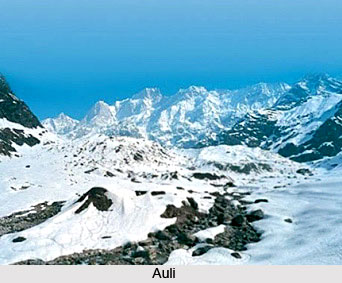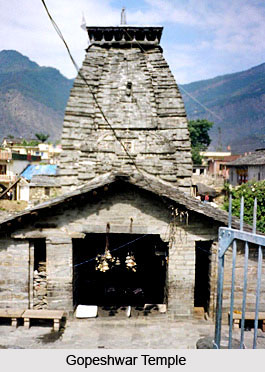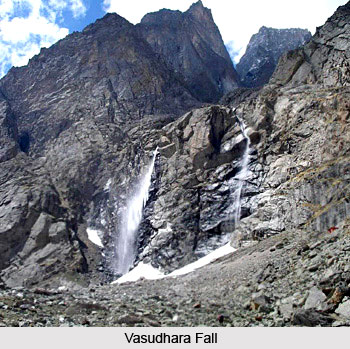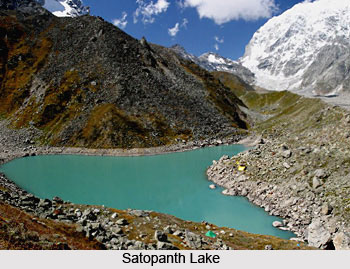 Tourism in Chamoli District will include visits to some of the most impressive places surrounded with natural scenery, water bodies and diverse wildlife. Chamoli District is known for its holy sites, temples, snow clad mountain peaks and beautiful scenic beauty. Chamoli District is blessed with diverse species of flora and fauna and natural splendor. Some of the main tourist attractions of Chamoli District are as follows -
Tourism in Chamoli District will include visits to some of the most impressive places surrounded with natural scenery, water bodies and diverse wildlife. Chamoli District is known for its holy sites, temples, snow clad mountain peaks and beautiful scenic beauty. Chamoli District is blessed with diverse species of flora and fauna and natural splendor. Some of the main tourist attractions of Chamoli District are as follows -
Auli: Auli is inviting in the summer season but in the winter season it is irresistible with its white snow slopes and skiing facilities. Auli can be reached by road or ropeway from Joshimath. It provides an excellent panoramic view of the giant mountain peaks like Nanda Devi, Kamet Peak and Dunagiri Peak. From January to March, Auli slopes are usually covered with a thick carpet of snow, about 3 metres deep. It offers a good skiing ground for the adventure lovers. The background of lofty snow clad mountains increases the sprit of the skiers. Moreover, to attract the attention of the travellers, skiing festivals are also conducted at Auli. While skiing is the chief attraction at Auli, there are other attractions like cable car rides and rope lifts.
 Gopeshwar: Situated at a height of 1308 metres amidst beautiful mountain ranges, terrace farms and small lakes, is the picturesque township of Gopeshwar. An ancient temple of Lord Shiva is the main attraction of the town and thousands of pilgrims come here throughout the year to visit the temple. Owing to its natural beauty and fresh and serene atmosphere, Gopeshwar is becoming a major attraction for the tourists. Many well known tourist spots and religious centres are spread around this town. According to historians, the name Gopeshwar has associations with the name of Lord Krishna. Besides the ancient temple of Lord Shiva, Baitarni Kund is another major attraction of the town.
Gopeshwar: Situated at a height of 1308 metres amidst beautiful mountain ranges, terrace farms and small lakes, is the picturesque township of Gopeshwar. An ancient temple of Lord Shiva is the main attraction of the town and thousands of pilgrims come here throughout the year to visit the temple. Owing to its natural beauty and fresh and serene atmosphere, Gopeshwar is becoming a major attraction for the tourists. Many well known tourist spots and religious centres are spread around this town. According to historians, the name Gopeshwar has associations with the name of Lord Krishna. Besides the ancient temple of Lord Shiva, Baitarni Kund is another major attraction of the town.
Vasudhara Fall: 5 kms from Mana village, toward the west is the Vasudhara fall, set in a background of snowy peaks, glaciers and rocky heights. Its view is breath taking.
Valley of Flowers: A profusion of wildflowers - iris, violets, roses, anemones, potentillas - mark this valley. It is celebrated all over the world for its lush beauty. A narrow river flows through the valley, now declared a national park. The best time to visit the valley is during July and August when innumerable varieties of flowers bloom and present a spectacular sight. The valley itself is 10 kms long and about 2 kms wide in conical shape.
Satopanth Lake: This triangular lake of serene water has a perimetre of about half a kilometer. It is about 25 kms from Badrinath. Lord Brahma, Lord Vishnu and Lord Shiva, the Hindu trinity is believed to occupy one corner each, and which are named after them. The trek is hazardous, but full of adventure.
Bedni Bugyal: Situated near Wan, Bedni Bugyal is a charming green meadow adorned with flowers in a spell binding varieties, in full bloom. There is a small lake situated in the midst of the meadow, where `Tarpans` are offered by the devotees.
 Roopkund: Roopkund is situated in the eastern part of Chamoli District. It is not a very large kund and is rather shallow, having a depth of only about 2 metres. The edges are snow covered for most parts of the year.
Roopkund: Roopkund is situated in the eastern part of Chamoli District. It is not a very large kund and is rather shallow, having a depth of only about 2 metres. The edges are snow covered for most parts of the year.
Badrinath: Badrinath is one of the `four dhams` of the country and is situated at an elevation of 3,133 metres above sea-level. Facing the temple at the bank of Alaknanda River is a hot water spring known as `Tapt Kund`.
Tapovan: In contrast to the annoying hustle and bustle of city life of Joshimath, Tapovan is a peaceful place known for its hot springs which are believed to possess miraculous healing powers. Tapovan is 15 kms from Joshimath.
Gwaldam: About 3 Kms from Baijnath, the main highways goes to Bageshwar and a side road branches off to Gwaldam. This is a delightful route as besides the presence of birds, adding a winsome note, one passes through terraced fields and thick pines set against a backdrop of the Himalayas, and one can watch the Trishul peaks coming even closer. Gwaldam with its salubrious climate is a little heaven nestling in the woods. In this area, upto Talwari , there are several orchards generally of apple. From Gwaldam, the road winds its way through dense forests and terraced fields dotted with rustic cottages of small towns known as Tharali and Narain Bagar to meet the Ranikhet-Pandukhal road at a place called Simli, which is 8 Km short of Karnaprayag. Gwaldam is 149 Km from Nanital and 22 km from Baijnath.
Joshimath: Joshimath has a temple dedicated to Narshimsha, an incarnation of Vishnu. There are several temples located here.
 Kagbhusandi Lake: This is a small oblong lake with emerald green water. It is at an altitude of 5230 metres, and is almost a km in length. Myriad blossoms decorate its banks. Set in the lap of Hathi Parbat (6730 metres), the lake can be approached either from Bhiundhar village, near Ghangria, or from Vishnu Prayag.
Kagbhusandi Lake: This is a small oblong lake with emerald green water. It is at an altitude of 5230 metres, and is almost a km in length. Myriad blossoms decorate its banks. Set in the lap of Hathi Parbat (6730 metres), the lake can be approached either from Bhiundhar village, near Ghangria, or from Vishnu Prayag.
Nanda Devi Sanctuary: Nanda Devi Sanctuary has been converted to a National Park and temporarily closed for visitors on environmental considerations. It has an average altitude exceeding 4500 metres and is surrounded several peaks, Nanda Devi being the highest. It is in the form of cup with lush green meadows, waterfalls, and rich wild flora and fauna.
Hemkund Sahib: Hemkund (Lake of gold), is situated nearly 29 kms from Joshimath. It is believed that Guru Gobind Singh had meditated on the bank of this lake in one of his earlier births.
Kuari Pass: Standing at the Kuari Pass facing north, the vision sweeps from the gorges of Trishul in the east to the peaks of Kedarnath in the west. One can approach the Pass from Tapovan. The entire area is rich in exotic flora and fauna
Rudranath Temple: It is one of the Panch Kedars of the country. Lord Shiva is worshipped here as Neelkantha. The temple is situated amid thick forest at a height 2286 metres.
Chamoli District is a boon for tourists and environment lovers offering immense scope for trekking and exploring.






